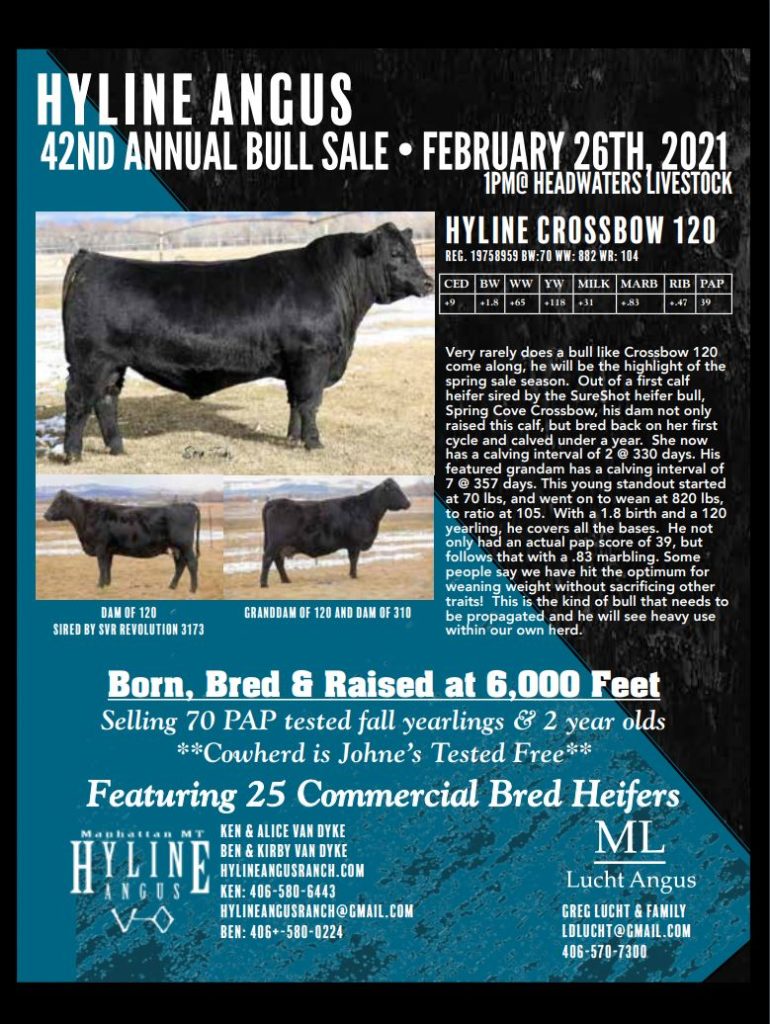The Hyline Bull Sale: An annual Montana Festival
By: John A. Baden, Ph.D.Posted on March 08, 2021 FREE Insight
Enjoying a Montana Festival: The 42nd Annual Hyline Angus Bull Sale at the Headwaters Arena
I enjoy introducing friends to traditional Montana experiences. A friend, Jeremy Carl, joined me in a trip to the Van Dyke family’s 42nd annual Hyline Angus Bull Sale at Headwaters Arena near Three Forks. This event is more than a straight commodity auction. It’s a cultural festival involving generations of many families. We were there for half a day and this was among the happiest places I’ve seen for a year.
Jeremy and his wife Anna, an ER doc, recently moved to Bozeman from San Francisco. His education is Yale, Harvard and Stanford and he is a Senior Fellow at the Claremont Institute. I knew the Hyline bull sale would be a fine introduction to a traditional, but new to him, culture and marketplace. And it was pleasure for both of us. These bulls, four dozen of them, had summered on our ranch—and some of the registered Hyline cows are wintering here now.
What the brochure didn’t claim, perhaps due to liability claims, is that the bulls are “nice” animals, none of them mean or aggressive toward people. Ben Van Dyke explained why: Any such animals are selected out. “We put wheels under them: Bulls that make people uncomfortable are trucked out of the herd.” Run that policy for twenty generations and the "keeper" bulls are easy to work with and handle.
A charming feature of the auction crowd were three- to ten-year-old girls and boys with their moms, dads, and grandparents. Little children were decked out in cowgirl and cowboy dress. Kids wearing little boots, hats, and jeans were tiny versions of their parents.
This auction represents the culmination of generations of careful breeding of fine Angus cattle. The four-color sales brochure has detailed data on each bull. It gives the birth weight, weaning weight, and considerable veterinary and physiological data on each animal. Some quite esoteric, “PAP and EPD tests for example. Animals’ birth weights, weight at weaning, and intervals between caving times of mother cows, are important. What it doesn’t claim, perhaps due to potential liability, is pleasant dispositions.

Low birth weights are good, especially for first-calf heifers. Heavy weaning weights also good, they show that the caves do well on their mother cows and while grazing spring and summer grass. An Angus cow should have a calf each year for ten to twelve years.
The kids can see why daddy, and sometimes mommy, get up at 3:00 AM in snowy winter and early wet spring, to watch over the cows giving birth. They give aid when needed and care for their animals, sometimes even taking calves into the back rooms of homes to get them warm and begin feeding. A friend, Brenda Sweeney, grew up on a ranch in western Kansas, here is her memory of winter and early spring calving: ……
Every early March, in the rural northwest corner of Kansas, spring snowstorms could be heavy, and the winds could be high, blowing horizontally. In the pastures of my dad’s 800-acre farm, heifer calves were due to be born any day.
During the cold, dark nights, my dad would set his alarm twice through the night to awake. Layered in heavy, warm clothes and face wrap, along with a high-powered flash light, he walked out to check for new births. If he didn’t, and the calves were born through the night, they could freeze to death. Not only was this a terrible loss of life, it was a loss of cash!
During the daytime, as a little girl, I remember standing at the door waiting for him to come back through the blinding snow and cold. When he finally came to the door, his eyebrows full of ice and his cheeks red and cold from the wind, I hugged him tightly. He was my hero!

The Headwaters Arena is just north of Three Forks, Montana. That’s where the Gallatin, Madison and Jefferson rivers join and form the Missouri River. Lewis and Clark and their Corps of Discovery arrived there on July 25, 1805. My friend, Jermey, and I joined this year’s Hyline Angus Sale February 26, 2021. It featured 70 yearling and two-year-old bulls and 25 heifers ready to drop calves this spring. The Hyline sales total was well over a third of a million dollars.
This auction, and many others through America, help enculturate children to life in agriculture. Anthropologists, and I’m one, recognize the bull sale as a cultural festival. It’s an event that complements FFA, Future Farmers of America and 4-H clubs. Festivals such as this one makes our community, the Greater Gallatin Valley, so attractive. It’s not just the scenery and recreation, we enjoy as especially attractive culture.
Some visitors to Montana experience or learn about events such as the Hyline Bull Sale, the Sweet Pea Festival, or the Winter Fair. These give a taste of a culture they find attractive. These, plus experiencing a friendly, safe, and non-woke environment makes our state an especially attractive place. It's a magnet for adventurous, active people with high human capital, a magnet likely to become even stronger.


